Workshop manuals for repair and maintenance motorcycle Harley-Davidson Sportster
See this section in russian language
This manual is intended for the repair and maintenance of small American motorcycles "Harley-Davidson Sportster" of various modifications, which were produced from 2012 to 2023.
Description and history of American motorcycles Harley Sportster
| Content: | K Series XL Sportster Changes by year Notable models Nightster XR1200 Forty-Eight Seventy-Two Roadster Sportster S Last models Buell |
The Harley-Davidson Sportster is a line of motorcycles that has been continuously manufactured since 1957 by Harley-Davidson. Sportster models are designated by a Harley-Davidson product code starting with "XL". In 1952, the predecessors of the Sportster, the K Sport and Sport Solo models, were marketed. These K models, KK, KH, and KHK from 1952 to 1956, had a side-valve engine ("flathead"), while the more recent XL Sportster models use an overhead valve engine. The first Sportster from 1957 featured many parts from the KH, including the frame, fenders, large gas tank, and front suspension.

Sportster XL883N, 2020 year, right view
The Sportsters are powered by a 45-degree V-twin four-stroke engine in which the two connecting rods, designed as "fork and blade" or "knife and fork", share a common crankpin. The original Sportster engine was the Ironhead engine, which was replaced by the Evolution engine in 1986.
The various Sportster engines include side-valve engines (1929 models R, D, G, and W of 737 cc) and "Big Twin" side-valve engines, which are the flathead V models of 1213 cc, the VL models (1930–1936), the U and UL models (1937–1948), and the VH and VLH models of 1311 cc from 1936. The UH and ULH models (1937–1941) have four distinct cams, with one lobe per cam.

Harley VL, 1930 year, left view
The cam followers used in the Sportster engines, the K models, the side-valve Big Twins, and the side-valve W model series were a slightly shorter version of the followers used in the larger engines, but with the same body diameter of 19 mm and the same roller follower diameter of 22 mm since 1929. The company used similar cam followers for decades, with minor modifications, from 1929 to the 1980s.

Harley UL, 1937 year, right view
Sportster engines retained the engine case design of the K and KH models, in which the transmission is contained in the same mold as the engine and driven by the engine with a 35-row chain primary drive and a multi-disc cable clutch. Since 1991, the models have had a five-speed gearbox; models from 1990 and earlier had four speeds.
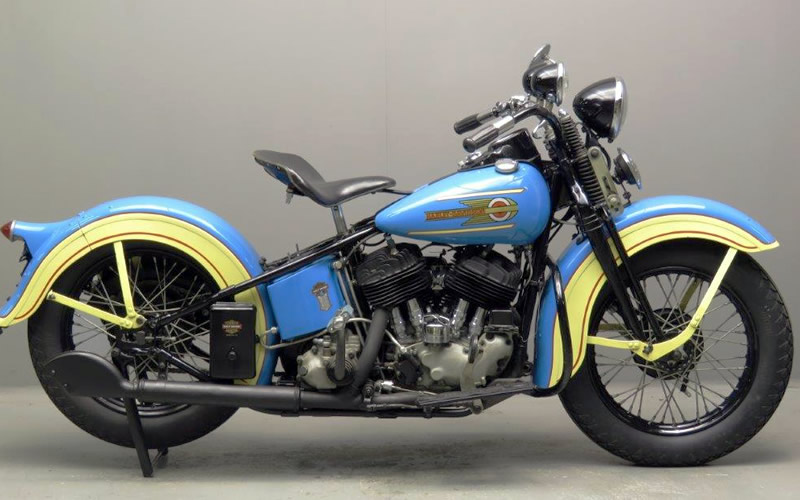
Harley ULH, 1938 year, right view
The engine was mounted directly to the frame from 1957 to 2003. While this system allows the motorcycle to be slightly lighter with more precise handling, it also transmits engine vibrations directly to the rider. In 2003, Harley-Davidson produced a limited number of sport models. They are identified by paint codes and centennial commemorative plaques marking the plates, speedometer housing, and engine. Sportsters marketed since 2004 and thereafter use rubber isolation mounts and linkages to limit engine movement in a single plane, significantly reducing vibrations felt by the rider. Buell motorcycles built with variants of the Sportster engine have used a rubber mounting system since 1987.
The Model K, from which the Sportster evolved, was the first civilian motorcycle produced by Harley-Davidson with hydraulic shock absorbers on both wheels. The model is commonly referred to as the "K model".
K Series
This series was developed from the previous 45 W model, but with a revised flathead side-valve engine and a new 4-speed transmission contained within the same cases that would be used on the Sportster. The Sportster inherits the connecting rods and many other components of similar design and dimensions.
K and KK Models 1952-1953: Side-valve engines of 750 cc, using the bore of the 45 model and a stroke of 70×97 mm.

Model K, 1952 year, right view
KR Model (competition only) 1953-1969: Side-valve engines of 750 cc.
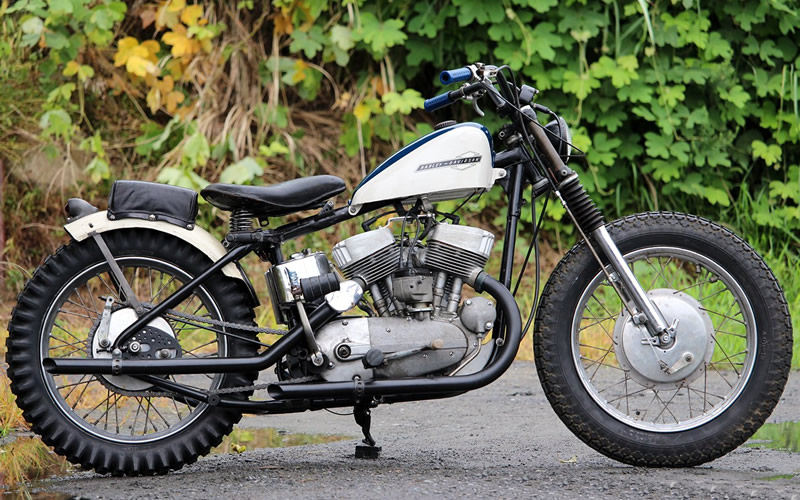
Model KR, 1953 year, right view
KH and KHK Models 1954-1956: Side-valve engines of 888 cc, using the bore of the 45 model, but with an increased stroke of 156 mm. This is the only small V-twin with a stroke longer than 97 mm. The shorter stroke, however, is universal for the entire 45/K/Sportster line from 1929 to the present, with the exceptions of the XR750 and XB9 Buell.

Model KHK, 1956 year, left view
XL Sportster series
XL Ironhead, 1957-1985: 883 cc and 1000 cc overhead valve Ironhead engines with cast iron heads, using the K series chassis.
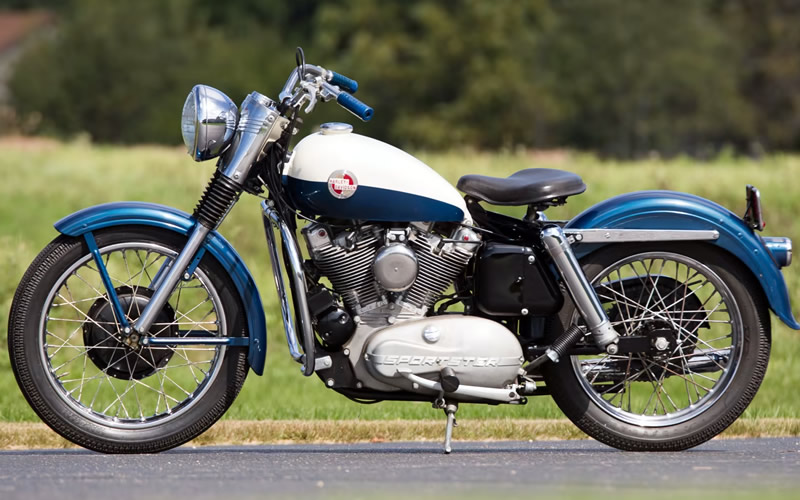
Sportster XL 883 Ironhead, 1957 year, left view
XLCH Ironhead (unofficial nickname "Competition Hot"), 1958-1971: 883 cc and 1000 cc starting from 1972.
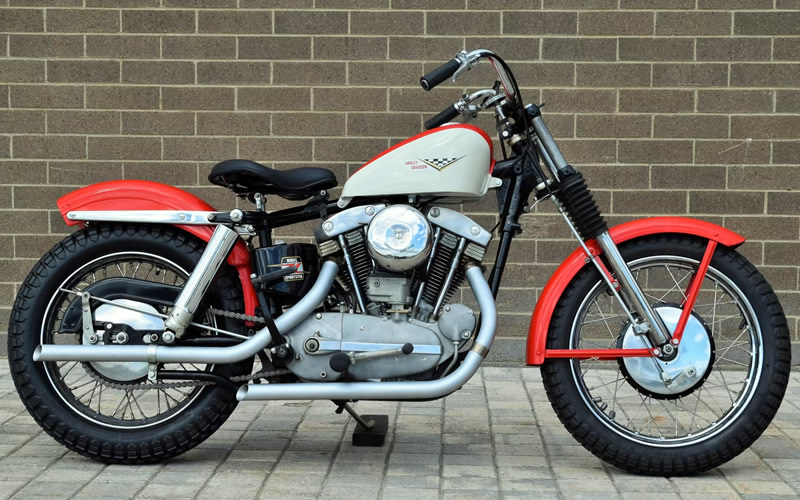
Sportster XLCH 883 Ironhead, 1958 year, right view
XR-750 (1970-1971): Competition model, except for the stunt bike of Evel Knievel sponsored by Harley-Davidson between 1970 and 1977, featuring a 750 cc overhead valve engine with steel heads.
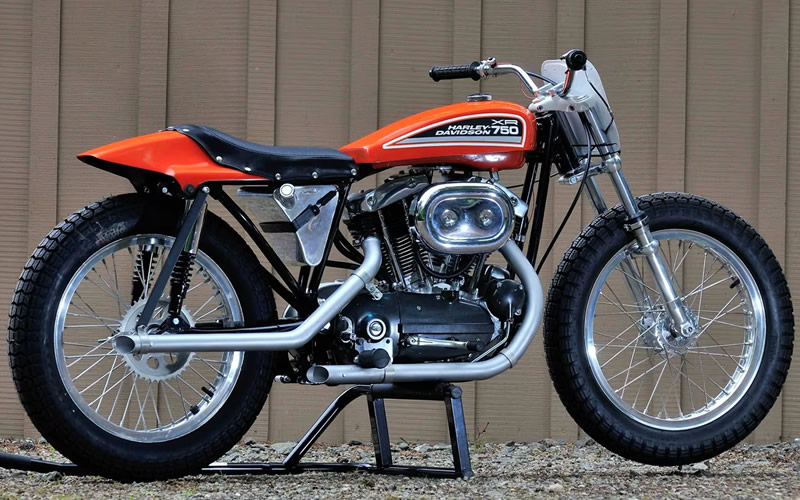
Sportster XR-750, 1970 year, right view
XR-750 (1972-1985): Exclusively for competition, with the exception noted above. 750 cc overhead valve engine with alloy heads.
XLCR (1977-1979): Café Racer with a 1000 cc overhead valve engine and steel heads. 2000 units in 1977, 1200 in 1978, and 9 in 1979.
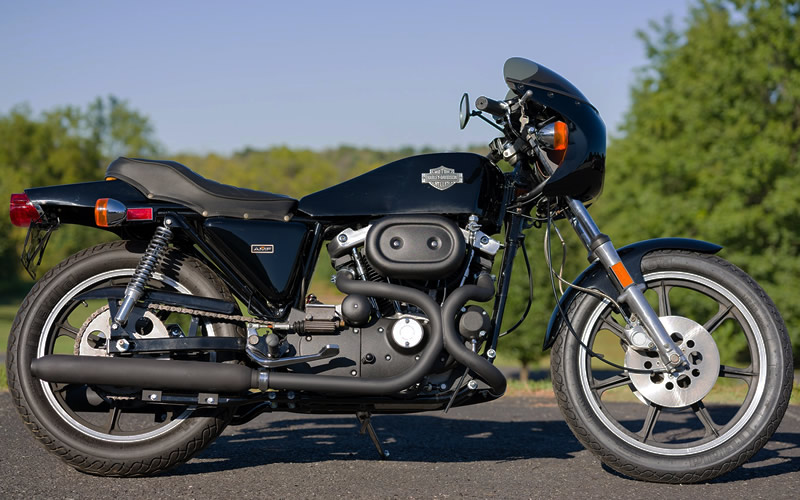
Sportster XLCR, 1977 year, right view
XR-1000 (1983-1984): Urban model with a 1000 cc engine using a competition XR head and other XR engine parts.
XLR: 883 cc overhead valve engines with steel heads.
XLS Roadster (1979-1982): Ironhead 1000 cc, 4-speed gearbox, stock parts — longer forks, two-person seat, sissy bar, highway pegs, 13.5-liter fuel tank (1979).
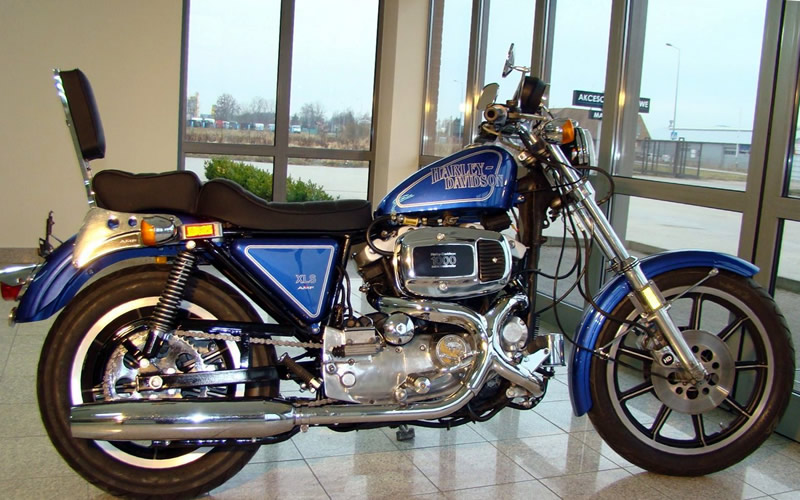
Sportster XLS Roadster, 1979 year, right view
XLS Roadster (1983-1985): Ironhead 1000 cc, 15-liter fuel tank with console.
XL Evolution (since 1986): Also known as "Evo". Evolution overhead valve engines of 883 cc, 1100 cc, and 1200 cc with alloy heads.
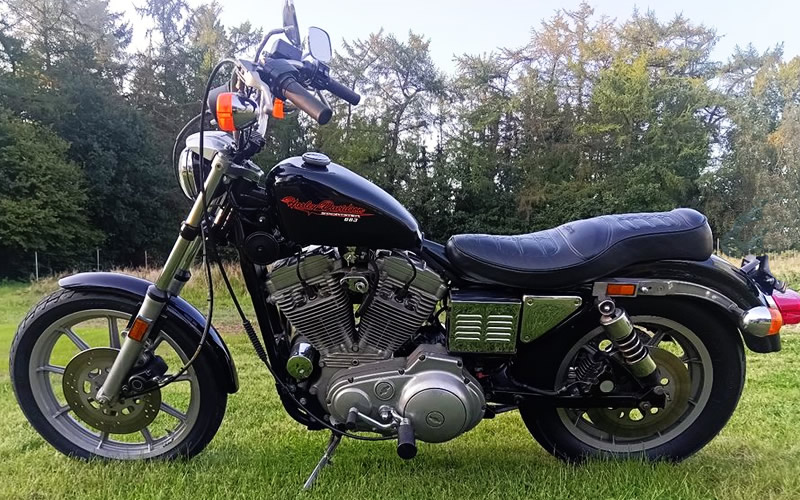
Sportster XL 883 Evolution, 1986 year, left view
Significant changes by year
1957: Introduction of the Ironhead overhead valve engine.
1958: Introduction of the high-compression XLH model and the more sporty XLCH "Competition Hot" model.
1967: Electric starter introduced on XLH.
1972: The 1972 Ironhead overhead valve engine replaces the 900 cc engine. The claimed power was 61 hp (45 kW) at 6200 rpm with a top speed of 187 km/h.
1975: Shift to left-side gear shifting (DOT mandate).
1976: Limited edition Liberty Edition commemorating the bicentennial of the United States.
1977 to 1979: Siamese dual exhaust pipes introduced on the XLCR café racer by Willie G. Davidson in 1977, along with the frame and rear hydraulic disc brake also introduced on the XLCR. Limited edition Confederate Edition Sportster produced for one year.
1979: Last year for kick start, only for XLCH (141 units).
1985: Last year for the Ironhead overhead valve engine.
1986: Evolution engine launched in 883 cc and 1100 cc.
1988: The 1200 cc engine replaces the 1100 cc engine.
1988: Constant velocity carburetor replaces the butterfly carburetor.
1991: Five-speed transmission replaces the four-speed transmission.
1991: Belt drive replaces chain drive on Deluxe 883 and 1200 models.
1993: Belt drive standard on all Sportster models.
1994: Improved oil tank, battery tray, and standard clutch.
1994: New electrical system with waterproof connectors.
1995: Speedometer is now electronic instead of mechanical.
1996: Custom model XL1200C.

Sportster XL1200C, 1998 year, right view
1998: Two spark plugs per cylinder and high-performance cams on the XL1200S.
2000: Introduction of sealed wheel bearings and four-piston brake calipers.
2003: Last year for the rigid-mounted Evolution engine on the 1957 frame.
2004: All-new frame with the engine mounted on rubber dampers to reduce vibrations. Removal of the transmission cover, new-shaped Hamcan, exhaust balancing pipe relocated under the air filter, concealed behind the mufflers for better engine visibility, new smoother right side oil tank panel with fill and gauge. The previously exposed battery is now enclosed behind a left-side matching panel.
2005: Rear swingarm widened to 25 mm for increased stability.
2006: The new XR1200 is unveiled at Intermot in Cologne, Germany. The XR1200 is the first Harley-Davidson to use Down Draft DDFI II fuel injection. Set to be released as a model at the end of 2006. Introduction of helical gears in the transmission (2nd-5th).
2007: Fuel injection replaces carburetors on all models.
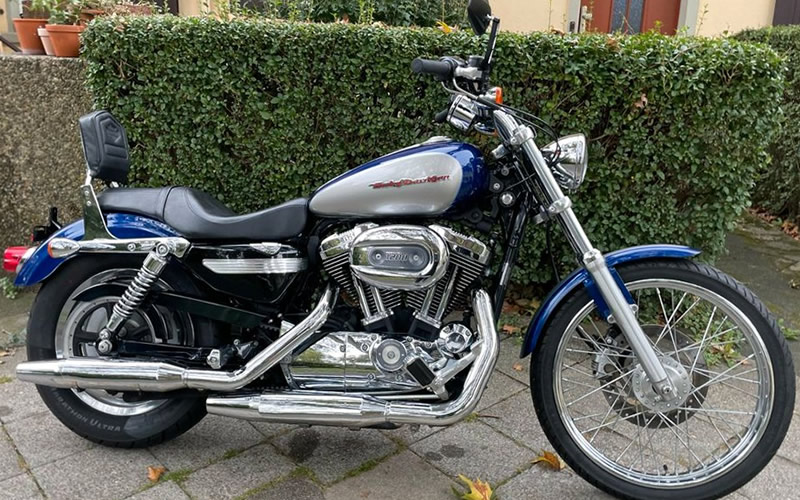
Sportster XL1200, 2007 year, right view
2008: Front fork diameter increases from 19 to 25 mm, and the rear arm diameter decreases from 25.4 to 25 mm.
2009: Individual approach for front fenders, replaced with a custom fender shape to match the wheel diameter of each model.
2010: The ECU is relocated to allow more variation in aftermarket seat selection. Side-mounted license plate option available on some models.
2014: New multiplexed electrical harness, larger brakes, ABS option for brakes, remote locking, new speedometer with speed/tachometer indicator, increased engine compression ratio, catalytic converter.
2021: Cessation of imports of Sportster models to Europe due to the inability to meet Euro 5 standards with the Evolution engine.
2021: Launch of the new Sportster S.
2022: Launch of the new Nightster.
2023: End of production for the Evolution engines (883 and 1200) and Sportster model range.

Sportster XL883, 2022 year, left view
Production and notable Sportster models
XL900: Original version with medium compression.
XLH900: Identical to the standard XL but with the "H" indicating the high-compression engine.
XLC900: Off-road version of the XL, the XLC is equipped only with magneto ignition and kickstart (as well as several other modifications aimed at reducing weight).
XLCH900: Off-road version of the XLH — or the XLC with the high-compression engine — the "CH" stands for "competition/high compression". After one year, lights, speedometer, and legal specifications for road use were added.
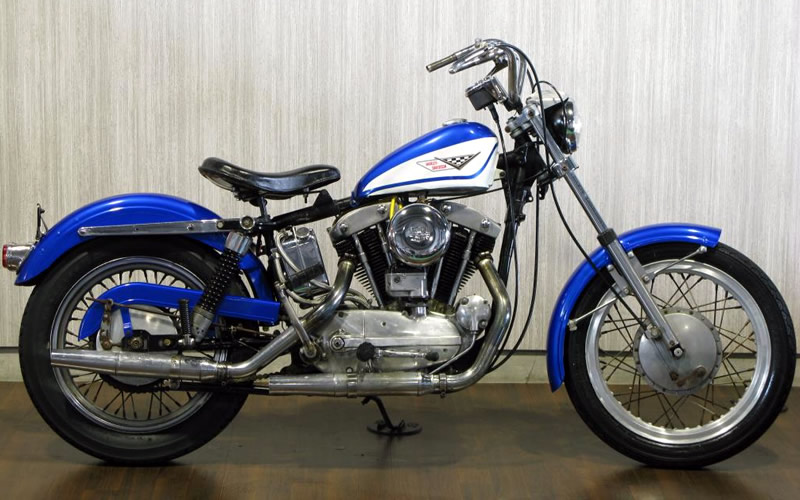
Sportster XLCH900, 1960 year, right view
XLX-61: Entry-level Sportster from the "Ironhead" era, available with thick black trim, black exhaust and handlebars, or red with chrome exhaust and handlebars.
XLT1000 Tourer (1977): Special model with a larger tank, windshield, a larger seat, and Superglide saddlebags.
XLCH, XLH, and XLT Harley-Davidson Confederate Edition (1977): Models with commemorative paint and decoration on the tank and fenders. Very limited production with only 45 XLCH models, 229 XLH models, and 15 XLT models.
XLCR1000 Cafe Racer: Available between 1977 and 1979.

Sportster XLCR1000, 1978 year, left view
XR1000: Two flat exhaust pipes positioned high on the left and two offset K&N filters feeding Dell'Orto carburetors on the right. 1000 cc engine with a combination of XLX Sportster parts and modified XR-750 parts.
XLH883 (1986-2006): Carburetor V-twin engine with a displacement of 883 cc.
XLH1100 (1986-2006): Carburetor V-twin engine with a displacement of 1100 cc.
XLH1200 (1986-2006): Carburetor V-twin engine with a displacement of 1200 cc.
XLH883 Deluxe: Dual seat, tachometer, crash bars, and spoke wheels (compared to the single seat, speedometer only, low bars, and alloy wheels on the standard XLH883 model).
XLH883 Hugger: Low seat height and reduced suspension, precursor to the "XL low" models.
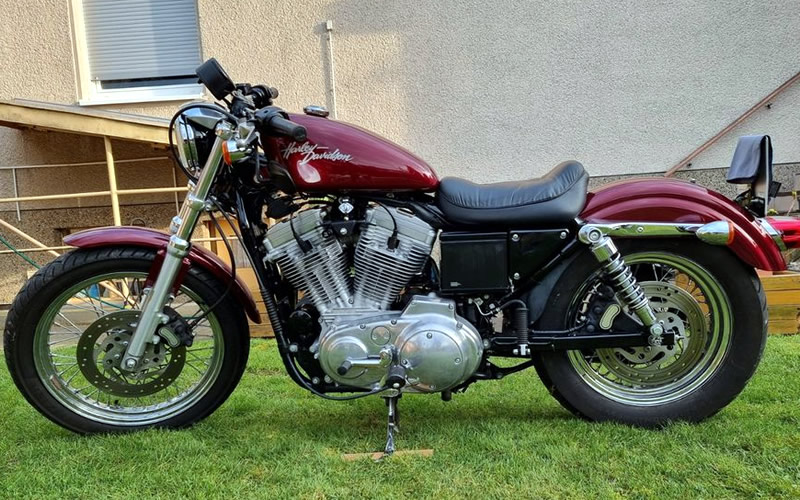
Sportster XLH883 Hugger, 2003 year, left view
XL53C Custom 53 (EU), XL883C Custom (US) 1998-2003 (883 cc): Forward controls, duo seat, solid rear wheel, and towing bars mounted on a riser. This model became the XL883C Custom worldwide with the rubber-mounted version released in 2004.
XL883 Sportster 883: Standard model with a solo seat, central controls, and either spoke or 13-spoke alloy wheels.
XL883C Custom: Wider and flatter custom tank, forward controls, duo seats, 21-inch spoke front wheels, and 16-inch solid rear wheels.
XL1200C Custom: Rigid-mounted versions on the frame had a dual seat and a wider standard tank; rubber-mounted models have a smoother seat and a flatter tank, all equipped with 21 and 16-inch disc wheels and forward controls.
XL883L Low: Solo seat, low shocks, mid controls, and either spoke or 13-spoke alloy wheels.
XL1200L Low: Dual seat, mid shocks, mid controls, wider and flatter "Custom" tank, and either spoke or 13-spoke alloy wheels.
XL1200S Sport: Equipped with adjustable suspension with piggyback base, dual disc front brakes, sharper cams, and 13-spoke alloy wheels. Later models are equipped with dual-plug heads.
XL883R Roadster: Features 2-in-1 exhaust, 13-spoke alloy wheels, and a black engine. Available in orange with "R" graphics, rubber-mounted models have 2-in-2 exhaust, a slightly different dual seat, and an option for spoke wheels. All R versions have three disc brakes and a tachometer. In 2010, the XL883R officially received the "Roadster" suffix.
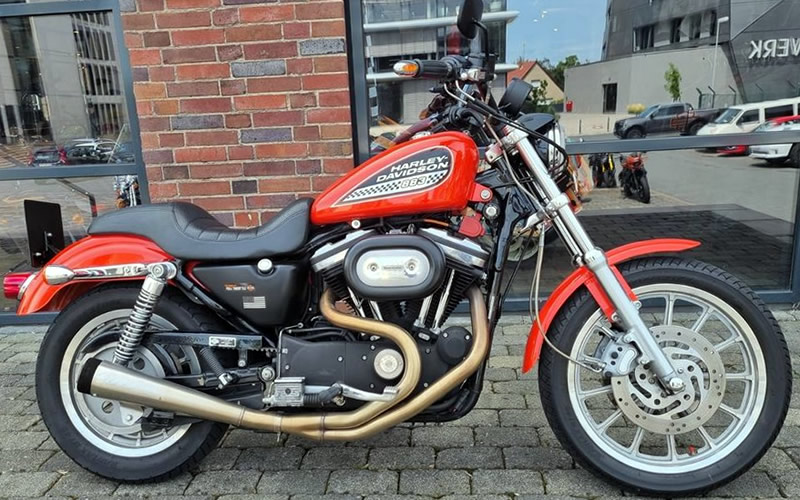
Sportster XL883R, 2001 year, right view
XL1200R Roadster: Black engine with highlighted fins, three disc brakes, tachometer, available in orange paint (but no "R" graphics or "08" model) with a flatter and wider tank that distinguishes it from the XL883R.
XL50 1200 50th Anniversary (2007): Limited production of 2000 units.
XL1200N Nightster: First of the Dark Customs to combine rear/stop lights with LED indicators, illuminated license plate, cone-shaped mufflers (side-cut mufflers for the U.S. market) mounted on the side, 279 mm shocks, mid controls, and spoke wheels.
XL883N Iron: Similar to the Nightster with more black parts, black Mag Wheels alloy wheels with 13 spokes, and central controls.
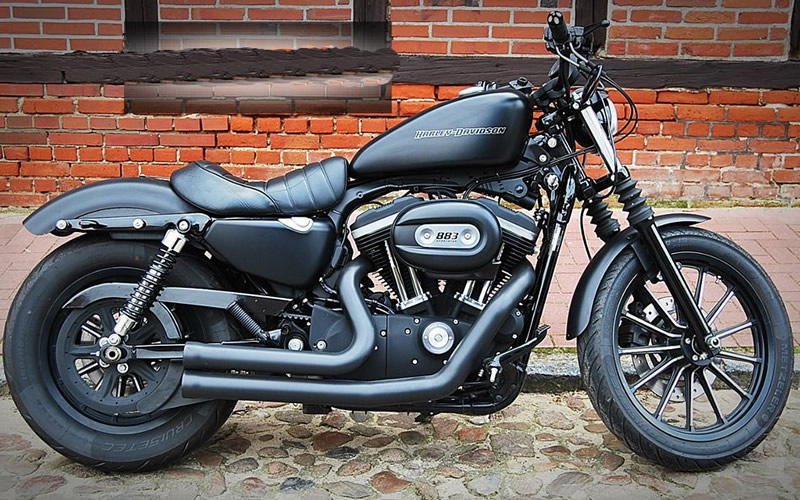
Sportster XL883N Iron, 2010 year, right view
XR1200: More sporty "Euro" style bike, inverted fork, reworked Sportster engine with XR heads, new frame, dual four-piston discs, aluminum wheels with three spokes (120/70-18 and 180/55-17), and rear-set controls. A series competition was created for this model.
XL1200X Forty-Eight: In the Dark style, the Forty-Eight features a small classic Peanut tank from 1948, spoke wheels, forward controls, a brand new 130 mm front tire, and a small solo seat.
XR1200X: XR1200 with fully adjustable rear shocks, fully adjustable front controls, available in Black Denim or White Denim paint colors.

Sportster XL1200R, 2011 year, left view
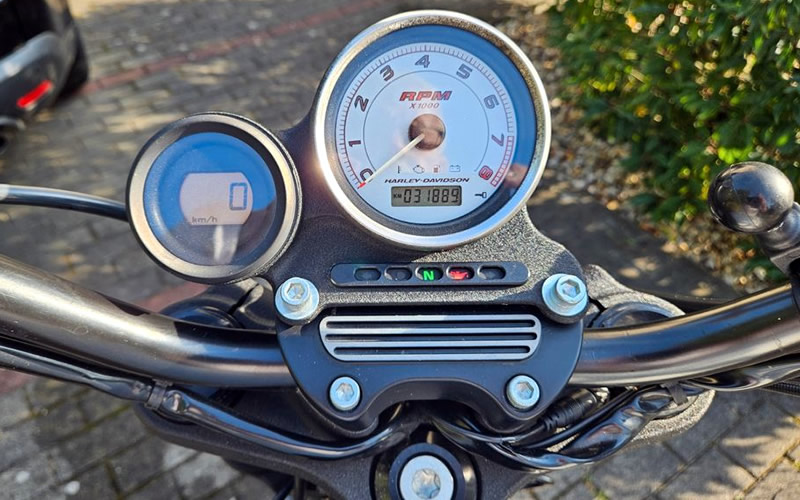
Sportster XL1200R, 2010 year, dashboard
XL883L SuperLow: New for 2011, polished black 5-spoke wheels and tires (120/70-18 and 150/60-17), wider and flatter Custom tank, mid controls.
XL1200C 1200 Custom: From 2011, 130/90B16 front tire, wide front fork, 5-spoke wheels (the UK receives spokes), a new headlight visor, and a wider Custom tank introducing the "H-D1".
XL1200V "72" Radical Chopper: Design inspired by the classic chopper/bobber style of the early 70s that was in vogue at the time. Hard Candy Custom paint (with metallic sparkles) is an option.
XL1200NS Iron: (2018-2021) Close to the 883 version with a black front headlight cover, mini-ape handlebars, central controls, and black Mag Wheels alloy wheels with 9 spokes.
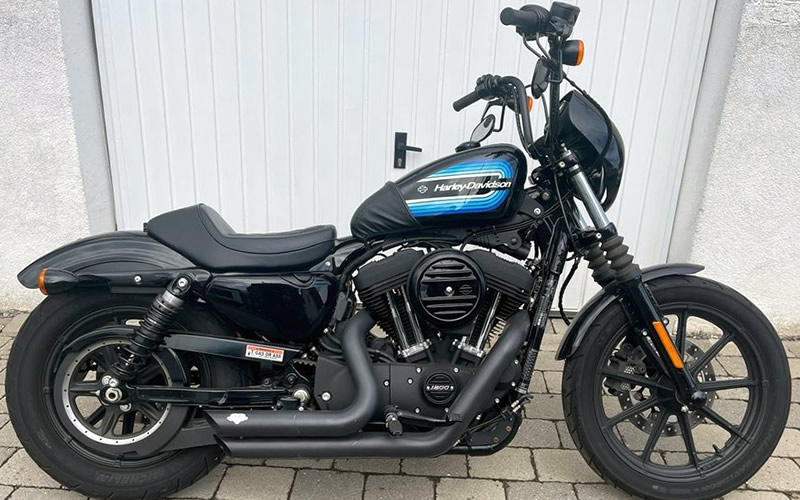
Sportster XL1200NS, 2019 year, right view
XL1200N Nightster
Introduced in 2007, the XL1200N Nightster featured unique elements such as a truncated rear fender, fork gaiters, and a side-mounted license plate. The riding position and seat height of the Nightster at 643 mm are identical to those of the XL883L Sportster Low. The European version (like the Iron 883/1200 and the Forty-Eight) has a central license plate, 343 mm rear shocks, cone-shaped mufflers, and combined LED tail/brake lights. The motorcycle has a measured power output of 57.2 hp (42.07 kW) at the rear wheel and a torque of 87.3 Nm. Its top speed is 172 km/h with a weight of 256 kg.
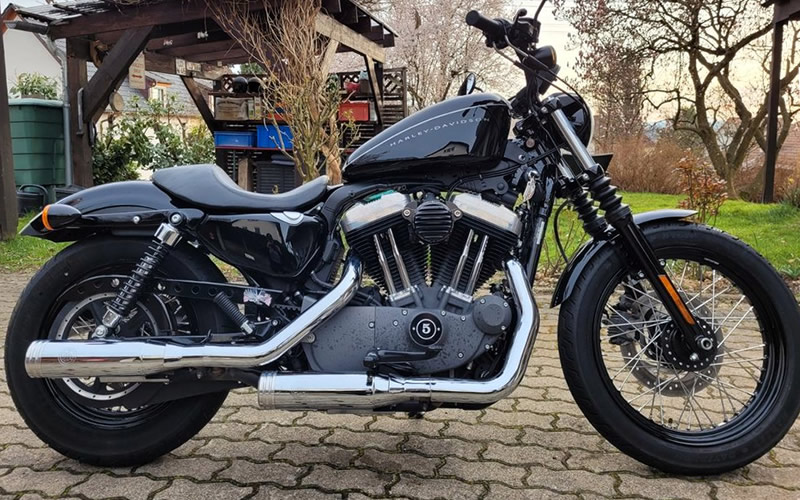
XL1200N Nightster, 2010 year, right view
The Harley Iron 883 released in 2009 is a "reduced" version of the Nightster. The main differences include a black engine, Moriss Mag alloy wheels instead of spoke wheels, a narrower handlebar, and of course, the smaller engine displacement. In 2018, the 1200 cc Iron version was released. Like the 883 version, it features a black theme but differentiates itself with tank decorations inspired by the AMF years, a black headlight cover, mini-ape handlebars, and a different seat.

XL1200N Nightster, 2008 year, dashboard
XR1200
In 2008, Harley-Davidson launched the XR1200 Sportster in Europe, Africa, and the Middle East. The XR1200 was equipped with an Evolution engine producing 91 hp (68 kW), dual four-piston disc brakes at the front, and an aluminum swingarm. The magazine Motorcyclist featured the XR1200 on its July 2008 cover and gave it an overall positive review. In its article "First Ride", the magazine repeatedly urged Harley-Davidson to market it in the United States. One possible reason for the late availability in the U.S. was that Harley-Davidson had to obtain the naming rights for "XR1200" from Storz Performance, a Harley customization shop located in Ventura, California.
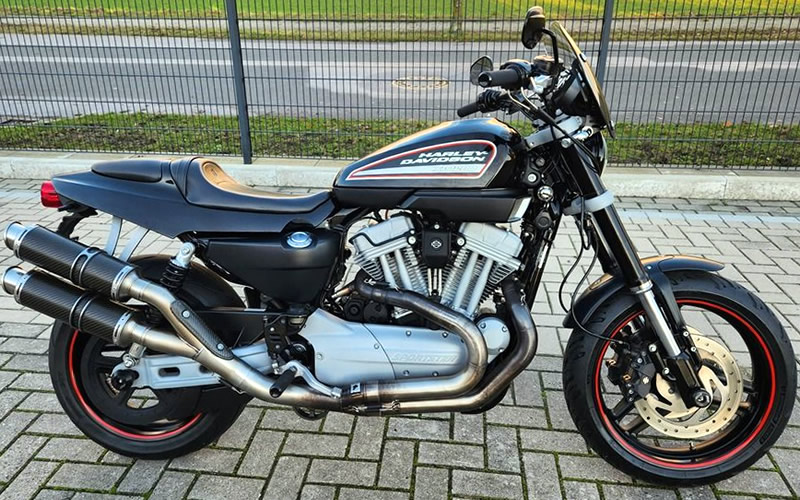
Sportster XR1200, 2009 year, right view
The XR1200 was released in the U.S. in 2009, in a special color palette that included Mirage Orange, highlighting its dirt-tracker heritage. The first 750 XR1200 units of 2009 were pre-ordered and featured a Number 1 plaque on the front of the motorcycle, signed by Kenny Coolbeth and Scott Parker, along with a thank-you and welcome letter from Harley-Davidson, signed by Bill Davidson. The XR1200 was discontinued in the U.S. market for the 2013 lineup. The motorcycle has a measured power output of 79.26 hp (58.3 kW) at the rear wheel and a torque of 91.56 Nm (rear wheel). Its top speed is 194.2 km/h with a weight of 260 kg.
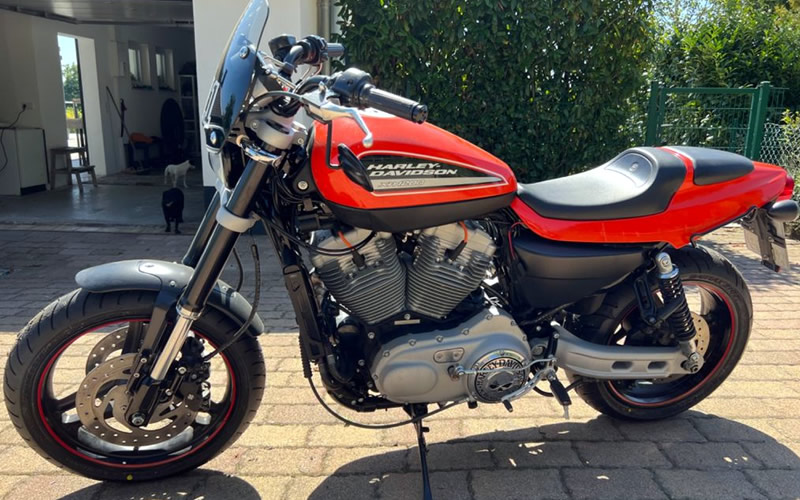
Sportster XR1200, 2008 year, left view
XL1200X Forty-Eight
Harley-Davidson introduced the XL1200X Forty-Eight model in 2010. It resembles the Dark style of the Nightster but features the small Peanut tank styled after 1948, spoke wheels, forward controls, a wider front tire with a large front fork, a reduced front fender, a small speedometer, inverted mirrors, a solo seat, and low-travel suspension.
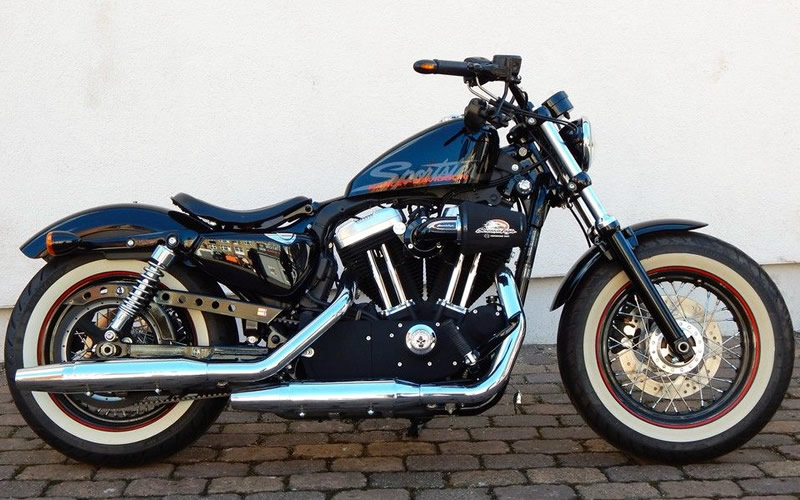
XL1200X Forty-Eight, 2011 year, right view
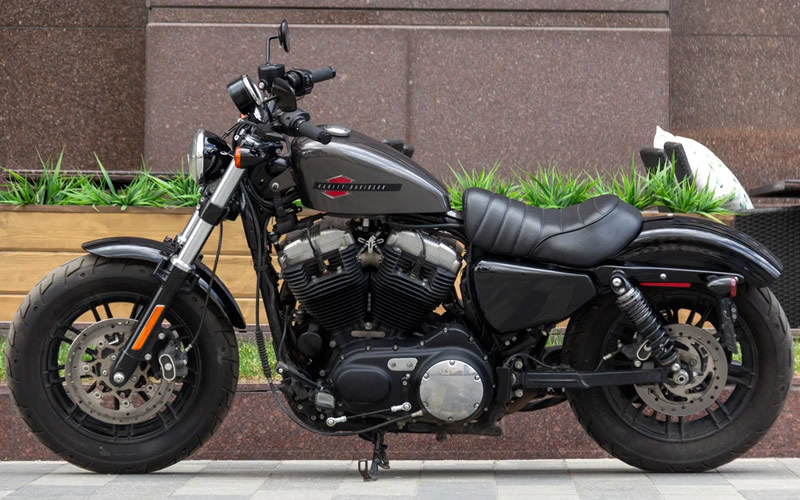
XL1200X Forty-Eight, 2021 year, left view
XL1200V Seventy-Two
In 2012, Harley-Davidson unveiled the XL1200V Seventy-Two, which was sold until 2016. It showcases the classic chopper/bobber style from the early 1970s. It includes a Peanut tank, spoke wheels, whitewall tires, forward controls, a slightly pronounced rake, slightly longer front forks, a short rear fender, a ape-hanger handlebar, and a low suspension. The motorcycle has a measured power output of 55.45 hp (40.78 kW) at the rear wheel and a torque of 81.09 Nm (rear wheel), with a top speed of 174 km/h and a full weight of 253.8 kg.
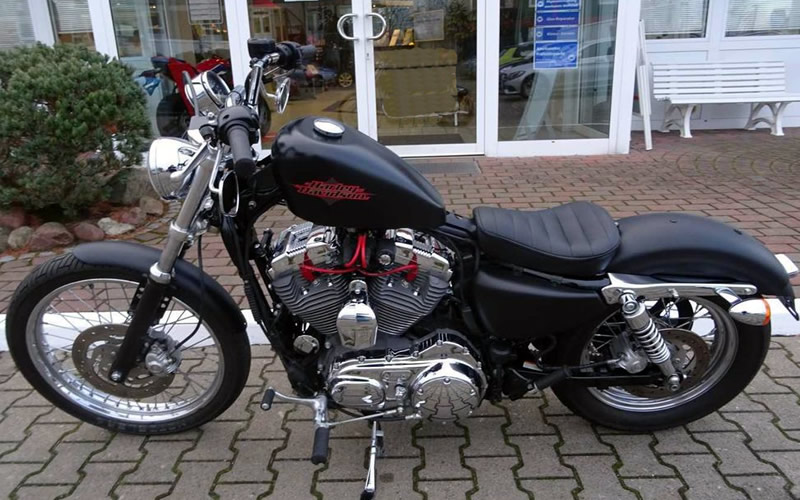
XL1200V Seventy-Two, 2014 year, left view
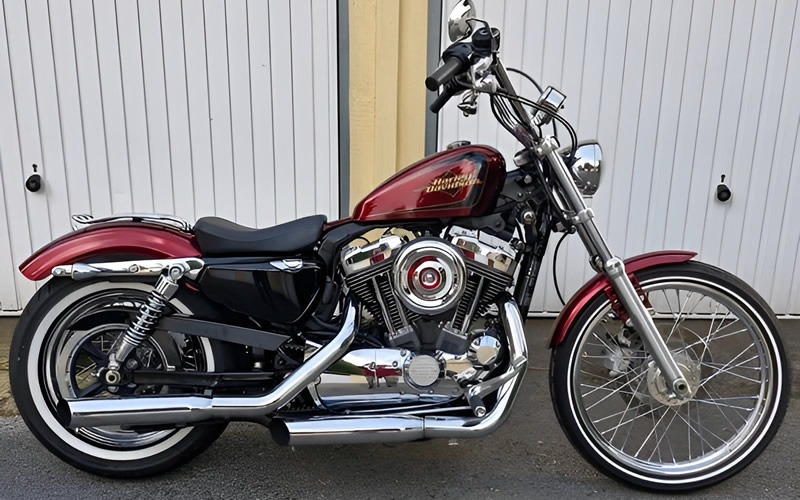
XL1200V Seventy-Two, 2012 year, right view
XL1200CX Roadster
In 2016, Harley-Davidson introduced the XL1200CX Roadster. This is the sporty Sportster that embodies the style and stance of a café racer. With mid-position controls and a drag bar handlebar, it offers a slightly forward-leaning riding position. A 43 mm inverted cartridge fork and adjustable preload emulsion shocks at the rear allow the Roadster to have the greatest lean angle of all the Sportsters. The motorcycle also features dual floating 300 mm disc brakes and a combination tachometer and speedometer. It has a measured power output of 65.4 hp (48.1 kW) at the rear wheel and a torque of 94.5 Nm (rear wheel).

XL1200CX Roadster, 2017 year, right view
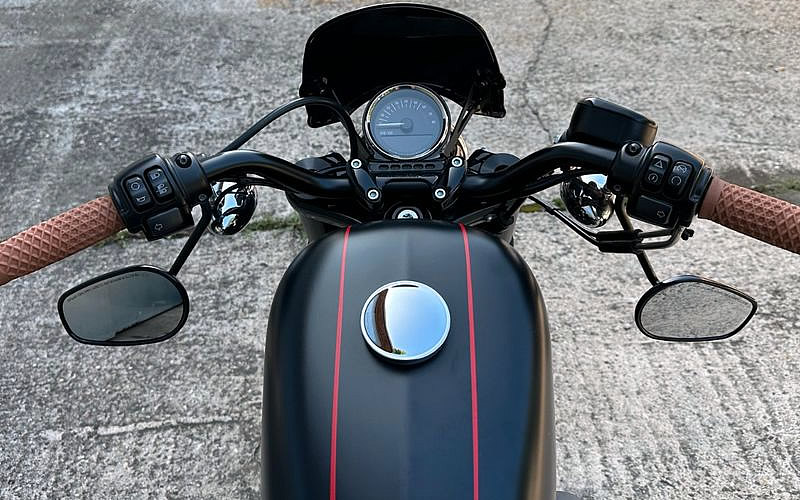
XL1200CX Roadster, 2016 year, dashboard
Sportster S
In 2021, Harley-Davidson launched the new Sportster S. Marketed as a "custom sport bike", it is equipped with the new Revolution Max 1250 T (for Torque) liquid-cooled V-twin engine with variable valve timing, first introduced on the Pan America. In the independent review, it notes: "Despite the name Sportster, the specifications of the new Sportster S show that it has more in common with the old V-Rod than its namesakes. By the end of its production, the V-Rod was equipped with a 1247 cc liquid-cooled DOHC V-twin engine producing 125 hp (91.94 kW), which is comparable to the 1252 cc and 121 hp (89 kW) of the new Sportster S. However, the V-Rod was a much heavier machine (around 300 kg depending on the version), whereas the Sportster S is a relatively lightweight machine at 228 kg. The result means that the new Sportster should be a significantly more performance-oriented machine than the old V-Rod, both in a straight line and in corners".
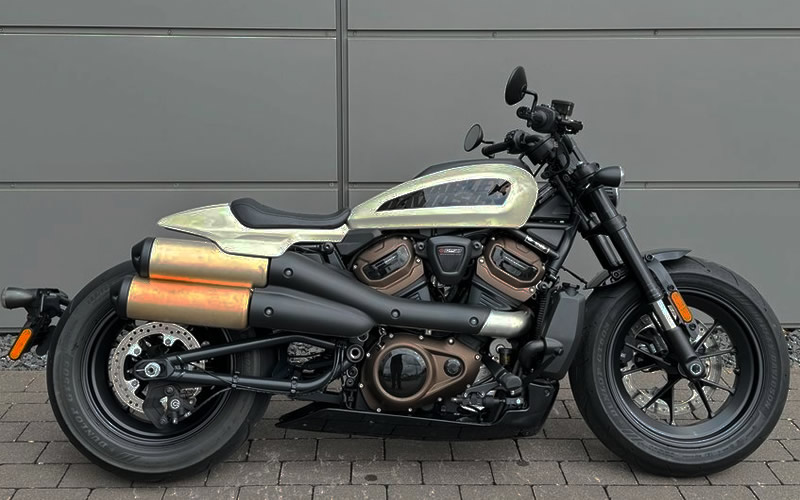
Sportster S, 2021 year, right view
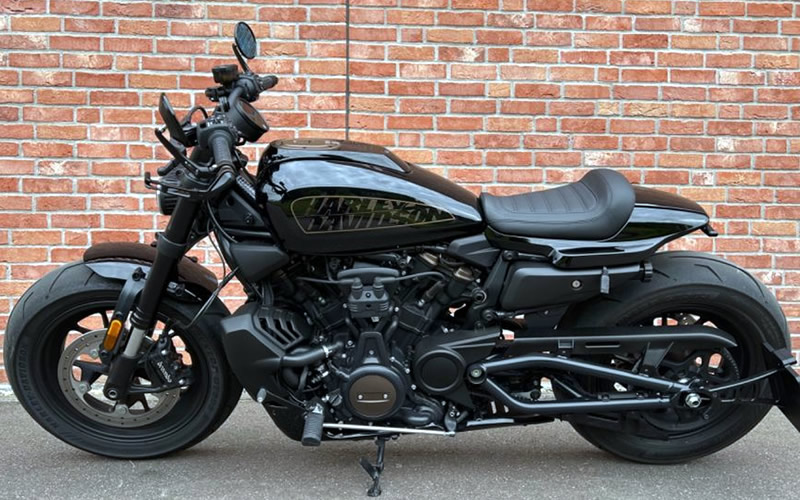
Sportster S, 2023 year, left view
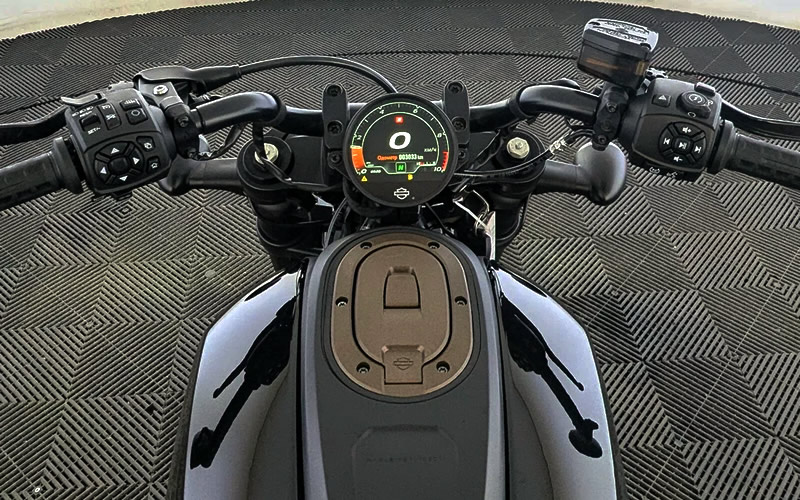
Sportster S, 2022 year, dashboard
Last Evolution models and current models
The Sportster with the air-cooled Evolution engine offered a variety of models in Europe until 2020:
- SuperLow (XL883L)
- Iron 883 (XL883N)
- Iron 1200 (XL1200NS)
- Forty-Eight (XL1200X)
- Forty-Eight Special (XL1200XS)
- 1200 Custom (XL1200C)
- SuperLow 1200T (XL1200T)
- Roadster (XL1200CX)
The 2024 models, which are not all offered in the same countries, are:
- Iron 883 (XL883N)
- Iron 1200 (XL1200NS)
- Forty-Eight (XL1200X)
- Sportster S (launched in 2021)
- Nightster

Nightster RH975, 2023 year, right view
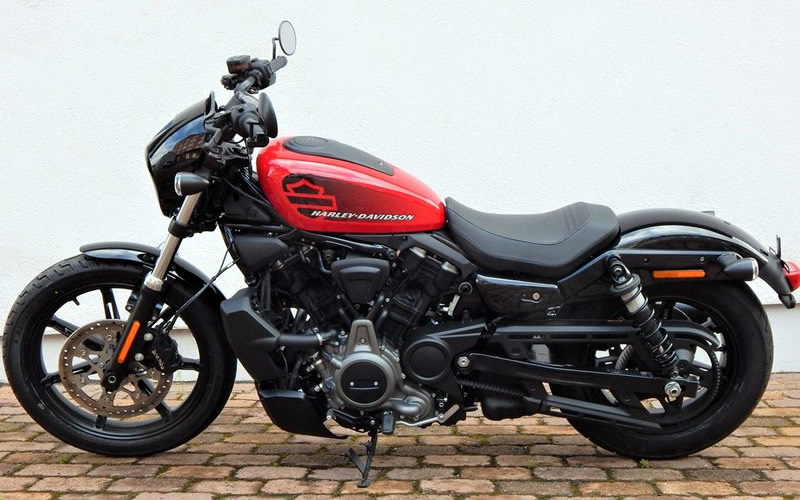
Nightster RH975, 2024 year, left view
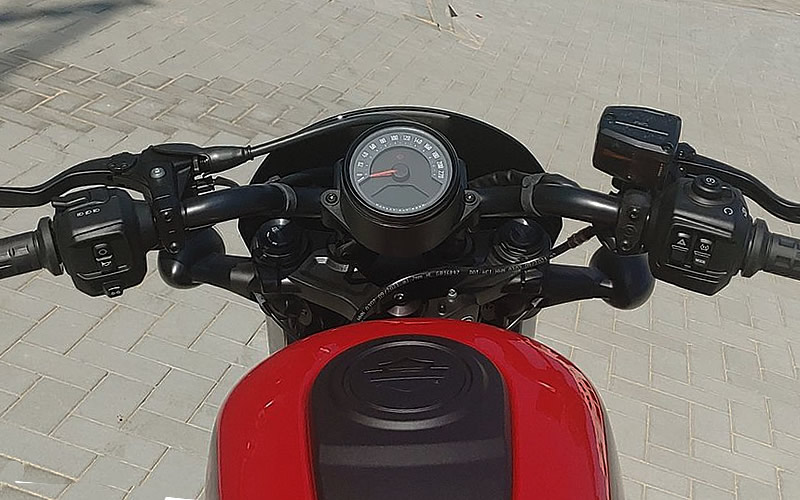
Nightster RH975, 2022 year, dashboard
Buell
The Buell brand began by modifying liquid-cooled 4-cylinder 4-stroke engines, eventually finishing with liquid-cooled 4-stroke V-twins, but the vast majority of their motorcycles used modified Sportster 883 and 1200 engines. Thanks to the addition of heads, cylinders, and fuel injection designed by Buell in 1999, these models all experienced an increase in power. These engines were also mounted on rubber mounts and were equipped with a fan for better cooling of the rear cylinder.
- Information for owner
- Maintenance
- Troubleshooting
- Engine and systems
- Engine repair
- Lubrication system
- Fuel system
- Transmission
- Running gear and frame
- Frame and hinged elements
- Front suspension and handlebar
- Rear suspension
- Brake system
- Wheels and tires
- Electric equipment
- Equipment and devices
- Lighting and lamps
- Starting and charging system
- Electrical circuits
